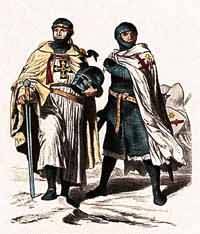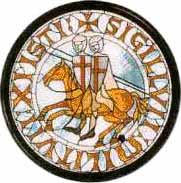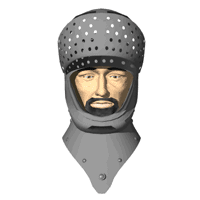  |
  |


The Knights Templars were the earliest founders of the military orders, and are the type on which the others are modelled. They are famed in history by their humble beginning, by their amazing growth, and by their tragic end.

Right after the deliverance of Jerusalem, the Crusaders, considering their vow fulfilled, returned to their homes concidering their work done. The defense of this precarious conquest, surrounded as it was by Mohammedan tribes, remained. In 1118, during the reign of Baldwin II, Hugues de Payens, a knight of Champagne, and eight companions bound themselves by a perpetual vow, taken in the presence of the Patriarch of Jerusalem, to defend the Christian kingdom. Baldwin accepted their services and assigned them a portion of his palace, adjoining the temple of the city; this is where they got their title "pauvres chevaliers du temple" (Poor Knights of the Temple). Poor indeed they were, being reduced to living on alms, and, so long as they were only nine, they were hardly prepared to render important services, unless it were as escorts to the pilgrims on their way from Jerusalem to the banks of the Jordan.
The Templars had as yet neither distinctive habit nor rule. Hugues de Payens journeyed to the West to seek the approbation of the Church and to obtain recruits. At the Council of Troyes (1128), at which he assisted and at which St. Bernard was the leading spirit, the Knights Templars adopted the Rule of St. Benedict, as recently reformed by the Cistercians. They accepted not only the three perpetual vows, besides the crusader's vow, but also the austere rules concerning the chapel, the refectory, and the dormitory. They also adopted the white habit of the Cistercians, adding to it a red cross.
Notwithstanding the harshness of the monastic rule, recruits flocked to the new order, which thenceforth comprised four ranks of brethren:
The knights, equipped like the heavy cavalry of the Middle Ages;
The serjeants, who formed the light cavalry;
Two ranks of non-fighting men:
The farmers, entrusted with the administration of temporals;
and the chaplains, who alone were vested with sacerdotal orders, to minister to the spiritual needs of the order.

The order owed its rapid growth in popularity to the fact that it combined the two great passions of the Middle Ages, religious fervour and martial prowess. This soon brought about conflict with the clergy of the Holy Land. As early as 1156 the clergy of the Holy Land tried to restrain the privileges of the military orders, but in Rome every objection was set aside, the result being a growing antipathy on the part of the secular clergy against these orders. The temporal benefits which the order received from all the sovereigns of Europe were no less important. The Templars had commanderies in every state. In France they formed no less than eleven bailiwicks, subdivided into more than forty-two commanderies; in Palestine it was for the most part with sword in hand that the Templars extended their possessions at the expense of the Mohammedans. Their castles are still famous owing to the remarkable ruins which remain: Safèd, built in 1140; Karak of the desert (1143); and, most importantly of all, Castle Pilgrim, built in 1217 to command a strategic defile on the sea-coast.
In these castles, which were both monasteries and cavalry-barracks, the life of the Templars was full of contrasts. A contemporary describes the Templars as "in turn lions of war and lambs at the hearth; rough knights on the battlefield, pious monks in the chapel; formidable to the enemies of Christ, gentleness itself towards His friends." (Jacques de Vitry). Having renounced all the pleasures of life, they faced death with a proud indifference; they were the first to attack, the last to retreat, always docile to the voice of their leader, the discipline of the monk being added to the discipline of the soldier. As an army they were never very numerous. A contemporary tells us that there were 400 knights in Jerusalem at the height of their prosperity; he does not give the number of serjeants, who were more numerous. But it was a picked body of men who, by their noble example, inspirited the remainder of the Christian forces. They were thus the terror of the Mohammedans.
Were they defeated, it was upon them that the victor vented his fury, the more so as they were forbidden to offer a ransom. When taken prisoners, they scornfully refused the freedom offered them on condition of abandoning their religion. At the siege of Safed (1264), at which ninety Templars met death, eighty others were taken prisoners, and, refusing to deny Christ, died martyrs to the Faith. This fidelity cost them dear. It has been said that in less than two centuries almost 20,000 Templars, knights and serjeants, perished in war.
All that was required of a new member was a blind obedience, as imperative in the soldier as in the monk. He had to declare himself forever "serf et esclave de la maison" (French text of the rule). To prove his sincerity, he was subjected to a secret test concerning the nature of which nothing has ever been discovered, although it gave rise to the most extraordinary accusations. The great wealth of the order may also have contributed to a certain laxity in morals, but the most serious charge against it was its insupportable pride and love of power. At the crest of its prosperity, it was said to possess 9000 estates. The Templars were soon opposed by the Order of Hospitallers, which had in its turn become military, and was at first the imitator and later the rival of the Templars. This ill-timed interference of the orders in the government of Jerusalem only multiplied the intestine dessentions, and this at a time when the formidable power of Saladin threatened the very existence of the Latin Kingdom. While the Templars sacrificed themselves with their customary bravery in this final struggle, they were, nevertheless, partly responsible for the downfall of Jerusalem.
To put an end to this baneful rivalry between the military orders, there was a very simple remedy at hand, namely their amalgamation. This was officially proposed by St. Louis at the Council of Lyons (1274). It was proposed again in 1293 by Pope Nicholas IV, who called a general consultation on this point of the Christian states. This idea is canvassed by all the publicists of that time, who demand either a fusion of the existing orders or the creation of a third order to supplant them. Never in fact had the question of the crusaders been more eagerly taken up than after their failure. As the grandson of St. Louis, Philip the Fair could not remain indifferent to these proposals for a crusade. As the most powerful prince of his time, the direction of the movement belonged to him. To assume this direction, all he demanded was the necesary supplies of men and especially of money. Such is the genesis of his campaign for the suppression of the Templars. It has been attributed wholly to his well-known cupidity. To justify such a course the sanction of the Church was necessary, and this the king could obtain only by maintaining the sacred purpose for which the possessions were destined. Admitting that he was sufficiently powerful to encroach upon the property of the Templars in France, he still needed the concurrence of the Church to secure control of their possessions in the other countries of Christendom. Such was the purpose of the wily negotiations of this self-willed and cunning sovereign, and of his still more treacherous counsellors, with Clement V, a French pope of weak character and easily deceived. The rumour that there had been a prearrangement between the king and the pope has been finally disposed of. A doubtful revelation, which allowed Philip to make the prosecution of the Templars as heretics a question of orthodoxy, afforded him the opportunity which he desired to invoke the action of the Holy See.

Philip the Fair made a preliminary inquiry, and, on the strength of so-called revelations of a few unworthy and degraded members, secret orders were sent throughout France to arrest all the Templars on the same day (13 October, 1307), and to submit them to a most rigorous examination. The king did this, it was made to appear, at the request of the ecclesiastical inquisitors, but in reality without their co-operation.
In this inquiry torture, the use of which was authorized by the cruel procedure of the age in the case of crimes committed without witnesses, was pitilessly employed. Owing to the lack of evidence, the accused could be convicted only through their own confession and, to extort this confession, the use of torture was considered necessary and legitimate.
There was one feature in the organization of the order which gave rise to suspicion, namely the secrecy with which the rites of initiation were conducted. The secrecy is explained by the fact that the receptions always took place in a chapter, and the chapters, owing to the delicate and grave questions discussed, were, and necessarily had to be, held in secret. An indiscretion in the matter of secrecy entailed exclusion from the order. The secrecy of these initiations, however, had two grave disadvantages.
As these receptions could take place wherever there was a commandery, they were carried on without publicity and were free from all surveillance or control from the higher authorities, the tests being entrusted to the discretion of subalterns who were often rough and uncultivated. Under such conditions, it is not to be wondered at that abuses crept in. One need only recall what took place almost daily at the time in the brotherhoods of artisans, the initiation of a new member being too often made the occasion for a parody more or less sacrilegious of baptism or of the Mass.
The second disadvantage of this secrecy was, that it gave an opportunity to the enemies of the Templars, and they were numerous, to infer from this mystery every conceivable malicious supposition and base on it the monstrous imputations. The Templars were accused of spitting upon the Cross, of denying Christ, of permitting sodomy, of worshipping an idol, all in the most impenetrable secrecy.
Most of the accused declared themselves guilty of these secret crimes after being subjected to such ferocious torture that many of them succumbed. Some made similar confessions without the use of torture, it is true, but through fear of it; the threat had been sufficient. Such was the case with the grand master himself, Jacques de Molay, who acknowledged later that he had lied to save his life.
The second phase of the process was the papal inquiry, which was not restricted to France, but extended to all the Christian countries of Europe, and even to the Orient. In most of the other countries -- Portugal, Spain, Germany, Cyprus -- the Templars were found innocent; in Italy, except for a few districts, the decision was the same. But in France the episcopal inquisitions, resuming their activities, took the facts as established at the trial, and confined themselves to reconciling the repentant guilty members, imposing various canonical penances extending even to perpetual imprisonment.
Only those who persisted in heresy were to be turned over to the secular arm, but, by a rigid interpretation of this provision, those who had withdrawn their former confessions were considered relapsed heretics; thus fifty-four Templars who had recanted after having confessed were condemned as relapsed and publicly burned on 12 May, 1310. Subsequently all the other Templars, who had been examined at the trial, with very few exceptions declared themselves guilty.
The pope reserved to his own jugment the cause of the grand master and his three first dignitaries. They had confessed their guilt; it remained to reconcile them with the Church, after they had testified to their repentance with the customary solemnity. To give this solemnity more publicity, a platform was erected in front of the Notre-Dame for the reading of the sentence. But at the supreme moment the grand master recovered his courage and proclaimed the innocence of the Templars and the falsity of his own alleged confessions. To atone for this deplorable moment of weakness, he declared himself ready to sacrifice his life. He knew the fate that awaited him. Immediately after this unexpected turn-a-round he was arrested as a relapsed heretic with another dignitary who chose to share his fate, and by order of Philip they were burned at the stake before the gates of the palace. This brave death deeply impressed the people, and, as it happened that the pope and the king died shortly afterwards, the legend spread that the grand master in the midst of the flames had summoned them both to appear in the course of the year before the tribunal of God.

| © RIYAN Productions |